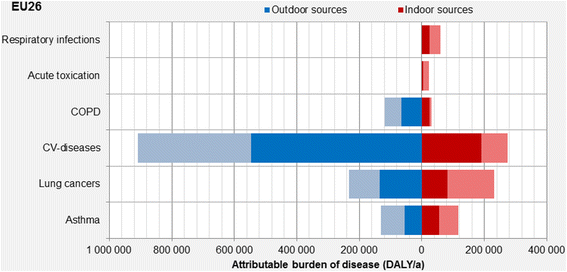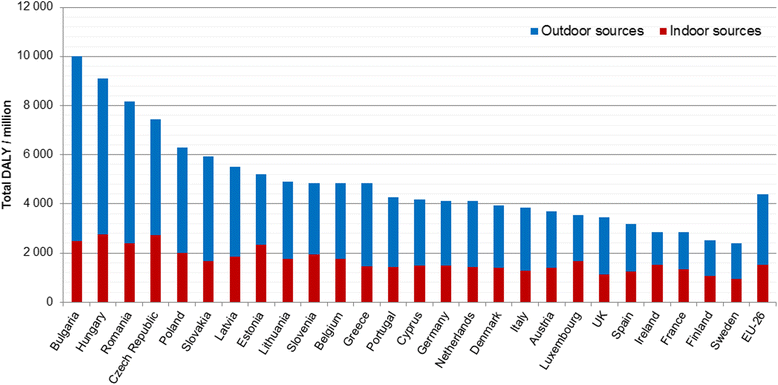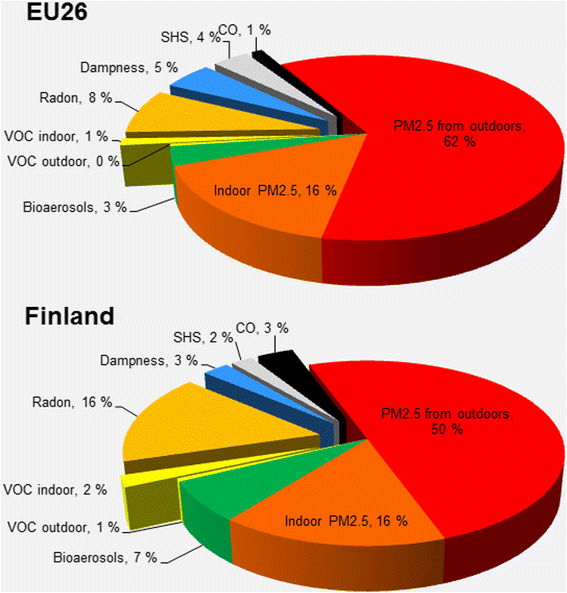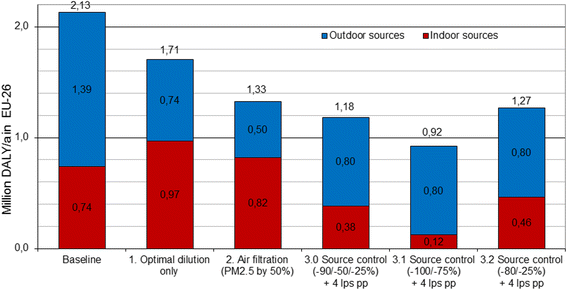Reducing burden of disease from residential indoor air exposures in Europe (HEALTHVENT project)
- PMID: 26961383
- PMCID: PMC4895703
- DOI: 10.1186/s12940-016-0101-8
Reducing burden of disease from residential indoor air exposures in Europe (HEALTHVENT project)
Abstract
Background: The annual burden of disease caused indoor air pollution, including polluted outdoor air used to ventilate indoor spaces, is estimated to correspond to a loss of over 2 million healthy life years in the European Union (EU). Based on measurements of the European Environment Agency (EEA), approximately 90 % of EU citizens live in areas where the World Health Organization (WHO) guidelines for air quality of particulate matter sized < 2.5 mm (PM2.5) are not met. Since sources of pollution reside in both indoor and outdoor air, selecting the most appropriate ventilation strategy is not a simple and straightforward task.
Methods: A framework for developing European health-based ventilation guidelines was created in 2010-2013 in the EU-funded HEALTHVENT project. As a part of the project, the potential efficiency of control policies to health effects caused by residential indoor exposures of fine particulate matter (PM2.5), outdoor bioaerosols, volatile organic compounds (VOC), carbon oxide (CO) radon and dampness was estimated. The analysis was based on scenario comparison, using an outdoor-indoor mass-balance model and varying the ventilation rates. Health effects were estimated with burden of diseases (BoD) calculations taking into account asthma, cardiovascular (CV) diseases, acute toxication, respiratory infections, lung cancer and chronic obstructive pulmonary disease (COPD).
Results: The quantitative comparison of three main policy approaches, (i) optimising ventilation rates only; (ii) filtration of outdoor air; and (iii) indoor source control, showed that all three approaches are able to provide substantial reductions in the health risks, varying from approximately 20 % to 44 %, corresponding to 400 000 and 900 000 saved healthy life years in EU-26. PM2.5 caused majority of the health effects in all included countries, but the importance of the other pollutants varied by country.
Conclusions: The present modelling shows, that combination of controlling the indoor air sources and selecting appropriate ventilation rate was the most effective to reduce health risks. If indoor sources cannot be removed or their emissions cannot be limited to an accepted level, ventilation needs to be increased to remove remaining pollutants. In these cases filtration of outdoor air may be needed to prevent increase of health risks.
Figures




References
-
- WHO: Dampness and mould. WHO Guidelines for Indoor Air Quality. WHO Regional office for Europe, Copenhagen 2009, ISBN 798 92 890 4168 3. [http://www.euro.who.int/document/E92645.pdf] (accessed 2014-08-22).
-
- WHO: Guidelines for Indoor Air Quality: Selected pollutants. World Health Organization, Regional Office for Europe, Copenhagen 2010, Denmark. ISBN 978 92 890 0213 4. [http://www.euro.who.int/__data/assets/pdf_file/0009/128169/e94535.pdf](a... 2014-09-22). - PubMed
-
- WHO: Air quality guidelines for Europe. World Health Organization, Regional Office for Europe, European series, No 23, Copenhagen 1987, Denmark. [http://www.euro.who.int/__data/assets/pdf_file/0005/74732/E71922.pdf] (accessed 2015-08-21).
-
- WHO: Air quality guidelines for Europe; Second edition. World Health Organization, Regional Office for Europe, No 91, Copenhagen 2000, Denmark. [http://www.euro.who.int/document/e71922.pdf] (accessed 2014-08-22).
-
- EN15251: CEN Standard on Indoor environmental input parameters for design and assessment of energy performance of buildings- addressing indoor air quality, thermal environment, lighting and acoustics. European Committee For Standardization (CEN) 2007, Brussels. 52 pp.
MeSH terms
Substances
LinkOut - more resources
Full Text Sources
Other Literature Sources
Medical
Research Materials
Miscellaneous

